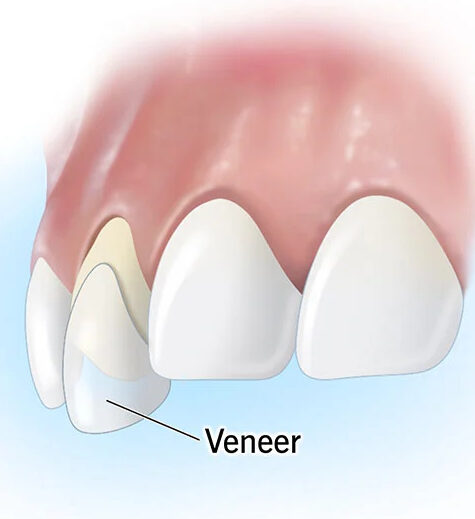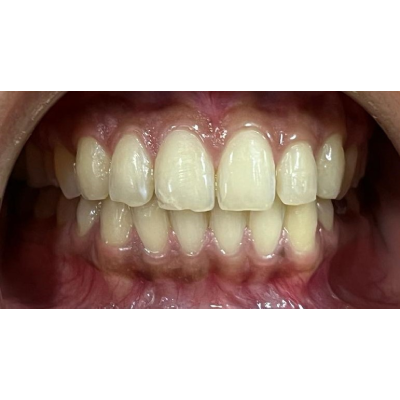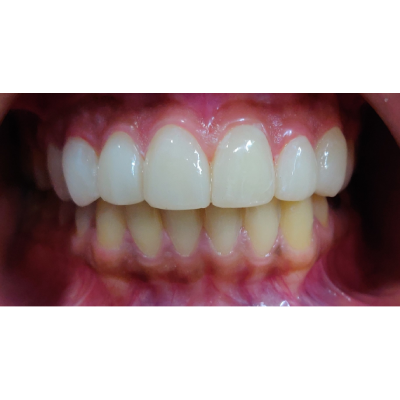Veeners
A dental veneer is a layer of tooth-coloured material which is attached to and covers the surface of a tooth. They are usually made of porcelain or composite resin. Composite resin veneers can be built up directly on to the tooth, while porcelain veneers are made in the laboratory and are later glued (bonded) on to the tooth.
To fit a veneer, the tooth will need a very small amount of enamel removed from its surface. This is usually completely pain free. A mould (impression) will be made of the tooth and the dentist will also record the colour that the new veneer will need to be in order to match the neighbouring teeth. This information will be sent to a dental laboratory who will make the veneer.
Until the veneer has been made the tooth may be more sensitive to hot and cold. A temporary veneer is not usually necessary.
At a later appointment the veneer will be bonded to the teeth.
Veneers are used in a variety of situations:

There are no strong reasons against veneering a tooth. However, certain factors increase their risk of failure, such as grinding of teeth, excessively worn teeth, very large fillings, unfavourable bite (occlusion), vomiting associated with bulimia and chronic alcoholism and acid regurgitation as in hiatus hernia. They may also be unsuitable if the teeth are very discoloured.
Veneers are best avoided in situations where the basic rules of dental hygiene are not observed.
Compared with a crown (cap), less of the tooth needs to be drilled away. Veneers are relatively quick and simple, although they require as much planning and attention to detail as any other treatment.
Potential problems
Veneers can occasionally become unstuck, and if they are stuck back on again the rebonding will not be as durable as the initial bond. It may also be difficult to match the shade of the veneer to the adjacent teeth if only one front tooth is being veneered.
During the first three days after fitting, while the glue is setting, it is advisable to keep to a soft diet and to avoid extremes of temperature. It is also wise to avoid alcohol and medicated mouthwashes during this initial stage.
Habit patterns such as nail biting or pencil chewing should be avoided, as well as biting into hard food, to prevent fracture of the veneer. Use of a soft mouthguard at night and when involved in any form of contact sport is recommended.
Routine oral hygiene procedures such as the use of a soft toothbrush and floss are a must. Electric toothbrushes may be used on veneers. If plaque removal from between the teeth is a problem, an interdental brush may be used. Use of a less abrasive toothpaste is recommended. The use of acidulated fluoride mouth rinses should be avoided as they might damage the surface finish of the veneers. Routine follow-up visits should be maintained with a dentist.
Although fractured veneers can be repaired, they are at best only a patchwork approach. Hence, the cosmetic outcome will be poor. If the fractured piece is preserved it could be stuck back or some composite resin material can be used to build up the defect. Although the best answer to the problem is to remake the veneer, the quality of the bond to the tooth achieved the second time around may not be as good as the first time.
Composite Bonding
Composite bonding is an increasingly popular cosmetic dental treatment that is used to improve the shape, colour and overall appearance of patients’ teeth. It uses the same resin material used for white fillings, and is most frequently used on the front teeth – those that show when you smile.
There have been huge advances in the materials used in bonding dentistry in recent years, meaning composite bonding can be used for disguising minor imperfections in the front teeth, closing small gaps and hiding minor tooth rotations, with no damage to your teeth.
Composite bonding is a pain-free experience that requires, in most cases, just one visit to the practice. Your dentist will be able to choose a shade of resin that closely matches the colour of your teeth, meaning that the results will look entirely natural.
This is how the treatment works:
Although composite bonding treatment does not last as long as veneers, many patients find the treatment is highly cost-effective. It can also be repeated with no damage at all to your teeth.
Smile makeover
If you are unhappy with the way your smile looks, you may be considering cosmetic dental treatment to improve the look of your teeth. There are a wide range of cosmetic treatments available at Aura Dental, with something to suit every patient’s needs and budget. For patients who are interested in cosmetic dentistry but are not sure which treatment best suits their needs, we provide smile makeovers.
Smile makeovers make use of the latest technology to assess your smile and work out which treatments will work best to give you the smile of your dreams.
You may be looking for a quick brightness boost in preparation for a special occasion such as a wedding or important business meeting, in which case tooth whitening may give you the smile you’ve always wanted. Alternatively, if your teeth are gappy, crooked or cracked, we may recommend porcelain veneers, composite bonding or discreet orthodontic treatment.
Once we’ve established what you want to achieve, we’ll use photographs, x-rays and in some cases models to show you what we can do, and discuss the best treatments for your individual case.
Here’s how it works:
E-max Veneers - Smile Design


Contact
- B-105, Tirth jyoti plaza, opp RTO gate, near subhash bridge circle, Ahmedabad, Gujarat 380027
- +91 96864 58860
- info@theauradent.com
